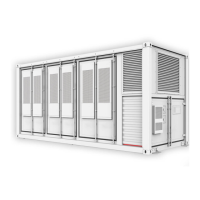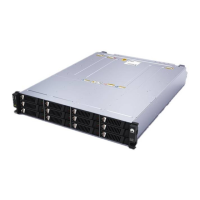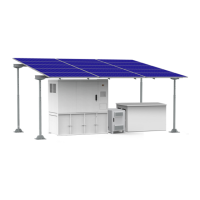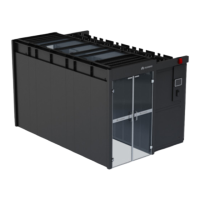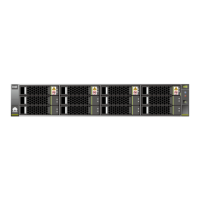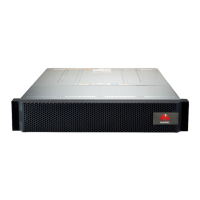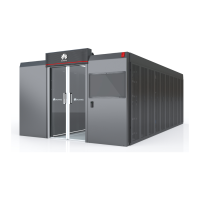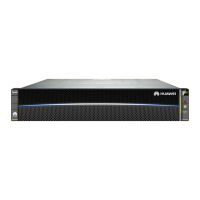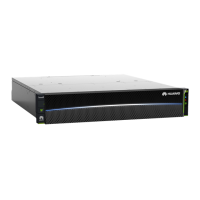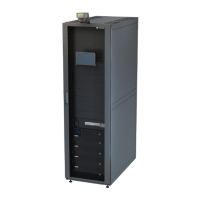Do you have a question about the Huawei LUNA2000-200KWH-2H1 and is the answer not in the manual?
Covers essential safety precautions related to personal handling and interaction with the equipment.
Details critical safety measures for electrical connections, operations, and hazard prevention.
Specifies environmental conditions crucial for safe installation and operation of the equipment.
Outlines safety guidelines for physical handling, installation, and moving of equipment.
Provides safety instructions specific to the equipment's components and operational integrity.
Details the naming convention and components of the product model.
Describes the core capabilities and beneficial characteristics of the product.
Illustrates the physical design, dimensions, and external features of the equipment.
Lists and describes the various internal and external parts of the system.
Details the system's power supply architecture and distribution components.
Explains the components and functions of the system's monitoring capabilities.
Describes the system's mechanisms for managing environmental conditions.
Details the components and operation of the integrated fire suppression system.
Describes the system's components and functions related to air exhaust.
Explains the fundamental operational logic and system interactions.
Illustrates common configurations and electrical connection diagrams for system deployment.
Guidelines for safe and compliant transport of the equipment, including handling and packaging.
Provides overarching guidelines for product storage environments and conditions.
Specific instructions for storing the ESS unit without its battery packs.
Details procedures for storing battery packs and managing their charge.
Guidelines for storing the Smart Rack Controller to maintain its condition.
Criteria and guidelines for choosing an appropriate installation site for the ESS.
Specifies the minimum space clearances needed around the equipment for installation and maintenance.
Details the necessary specifications and considerations for the equipment's foundation.
Guidelines and specifications for using forklifts to move the equipment safely.
Safety procedures and requirements for lifting and hoisting the equipment.
Steps and considerations before commencing the installation process.
Lists the necessary tools required for the installation of the equipment.
Procedures for verifying the equipment's condition and completeness before installation.
Step-by-step instructions for the physical installation of the Energy Storage System (ESS).
Procedures for properly connecting the grounding cable to the ESS.
Guides for installing various system components and accessories.
Instructions for installing the integrated fire suppression system within the rack.
Detailed steps for safely installing the battery packs into the system.
Procedure for installing the Smart Rack Controller unit into the system.
Instructions for installing the Smart Power Control System (PCS) unit.
Guide for installing an optional maintenance socket for system access.
Instructions for installing the optional DDSU666-H meter.
Information on selecting and preparing cables for system connections.
Steps for connecting cables to the fire suppression system.
Procedure for connecting the power and communication cables to battery packs.
Instructions for connecting cables to the Smart Rack Controller.
Steps for routing and connecting the DC power cable.
Procedure for connecting the auxiliary AC power cable from the grid.
Instructions for connecting a single-phase AC input power cable.
Guides for connecting various communication cables for system networking.
Steps for connecting the Fast Ethernet (FE) communication cable.
Procedure for connecting fiber optic cables in a ring network topology.
Guide for connecting cables for the optional DDSU666-H meter.
Instructions for connecting cables for an optional maintenance socket.
Procedure for sealing cable entry points after cable installation.
Pre-power-on checks to ensure correct installation and configuration.
General inspection checklist before system power-on.
Specific checks for the ESS unit installation status.
Checks related to the proper installation of the Smart PCS.
Checks for the correct installation of the Smart Array Controller Unit (SACU).
Procedure for installing the Power Supply Unit (PSU) into the system.
Step-by-step guide for powering on the system components.
Detailed steps for powering on the Smart Array Controller Unit (SACU).
Procedure to power on the AC power supply loop of the distribution cabinet.
Final steps and checks for powering on the Energy Storage System (ESS).
Steps for preparing the PC and logging into the SmartLogger WebUI.
Procedure to verify the installed software version of the SmartLogger.
Instructions for upgrading the SmartLogger software package.
Steps for resetting the Energy Storage Unit (ESU) and checking its status.
Guide to using the deployment wizard for system configuration.
Optional procedure for starting up system devices via the WebUI.
Process for checking and handling system alarms via WebUI or CMU.
Configuration steps for setting capacity limits for system operation.
Procedure to issue a shutdown command via the SmartLogger WebUI.
Step-by-step guide for safely powering off the system components.
Instructions for powering off individual Energy Storage System (ESS) devices.
Procedure to disconnect the AC power supply loop for safety.
Details for the water alarm, including cause and suggestion for resolution.
Information on the door status alarm, its causes, and recommended actions.
Troubleshooting for high temperature alarms in air conditioning units.
Guidance for addressing high-pressure alarms in the air conditioning system.
Information on handling combustible gas alarms related to battery safety.
Troubleshooting for communication failures between battery packs and the rack controller.
Guidance for resolving overvoltage issues on the battery side of the rack controller.
Troubleshooting steps for abnormal battery pack monitoring boards.
Information on resolving faults within the battery pack optimization unit.
Steps to address loose connections on copper bars within the battery pack.
Guidance for handling battery pack overcurrent alarms.
Details the configuration of the single-cabinet rack controller.
Specifies the rated energy capacity of the single-cabinet battery.
Defines the acceptable range of ambient temperatures for operation.
Describes the type and specifications of the fire suppression system.
Guidelines on selecting appropriate terminals for different cable types.
Detailed procedure for correctly crimping OT or DT terminals onto cables.
Conditions and materials required before starting paint repair.
Overview of how to assess and describe paint damage for repair.
Step-by-step instructions for performing paint damage repair.
Procedures for handling battery damage from impact or falling.
Safety measures and disposal instructions for batteries exposed to water.
Critical safety instructions and actions to take in case of a fire incident.
Immediate actions to take when a fire alarm horn or strobe is activated.
Safety precautions related to gas exhaust vents during operations.
Guidelines for onsite personnel and firefighters during fire events.
Information on contacting agencies and procedures for recycling used batteries.
Detailed guide on performing operations using the CMU Web User Interface.
Specific operational procedures within the CMU WebUI.
An overview of the CMU Web User Interface.
Description of the graphical layout and elements of the WebUI.
Explanation of the icons used within the WebUI interface.
Listing and description of the main navigation menus in the WebUI.
Procedures for performing maintenance tasks on the CMU.
Steps required to prepare for and log into the CMU WebUI.
Instructions for upgrading the CMU's software version.
Procedure for exporting device logs for analysis and troubleshooting.
Steps to check and review active system alarms.
Procedure for clearing active and historical alarms from the system.
Instructions for downloading and installing the SUN2000 mobile application.
Steps required to log in to the SUN2000 mobile application.
Procedure for changing user login passwords for the app and WLAN hotspot.
Contact details for customer service and technical support.
A comprehensive list of acronyms and abbreviations used in the document.
| Battery Type | Lithium Iron Phosphate (LFP) |
|---|---|
| Rated Power/Max. Discharge Power/Max. Charge Power | 100kW/100kW/100kW |
| Usable Energy | 200 kWh |
| Cooling Method | Air cooling |
| Cycle Life | 6000 cycles |
| Communication | CAN, RS485 |
| Installation Location | Outdoor |
